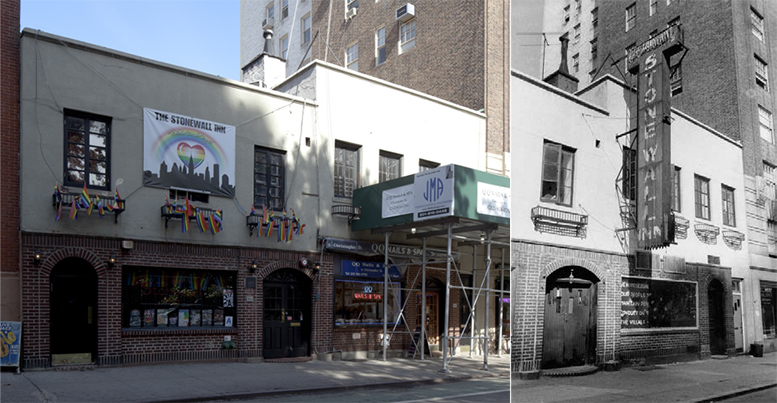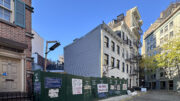The Stonewall Inn, located at 51-53 Christopher Street, has been designated an individual landmark by the Landmarks Preservation Commission. The unanimous vote took place Tuesday shortly before noon and was greeted by a roar of applause. This unusual move gives the bar’s history as part the LGBT rights movement the official city recognition many say it deserves.
The move to designate was unusual because the Stonewall Inn already sits in the Greenwich Village Historic District, which protects it from demolition or exterior modification. However, the district was designated almost two months prior to the events that began June 28, 1969, known as the Stonewall Rebellion, the Stonewall Uprising, and/or the Stonewall Riots. That meant the police raid that set off days of protest was not mentioned in the report. Now, any attempt to modify the building will be guided by official recognition of its history.
Today was the public hearing for this designation and the vote to designate often at a subsequent session of the LPC, but Chair Meenakshi Srinivasan said, following over 25 pieces of public testimony, “The people have spoken.” She then suggested the commissioners reach a decision today.
The designation of the Stonewall Inn marks a recognition of the changing role of the commission. As Srinivasan pointed out, the city, when viewed from a world perspective is still quite young, but the Stonewall Inn represents our social change, not architecture. Several commissioners recognize that they will need to recognize more cultural sites that don’t actually have much, if any, architectural merit. Commissioner John Gustafsson said “When is a stable not just a stable?” and added that history trumped architectural value in this case. Commissioner Michael Devonshire said “This ain’t a pretty building,” but said the “period of strength and dignity” of the gay rights movement deserves recognition. Commissioner Michael Goldblum said recognizing cultural sites will be “a challenge and an opportunity.”
“HDC supports the designation of the Stonewall Inn as an Individual Landmark. While the structure itself is already protected as part of the Greenwich Village Historic District, this designation would more intentionally acknowledge and honor this site’s cultural and historical significance to our city and, indeed, the world,” said the Historic Districts Council’s Barbara Zay. “Protecting the physical spaces that embody history, like Stonewall, is a crucial, if less traditional, task with which the Landmarks Commission is charged.”
“Few sites anywhere in New York have the international resonance of Stonewall. The riots and protests following the police raid on this bar on June 28, 1969 are commemorated annually in literally thousands of cities in scores of countries throughout the world. In this country, the reverberations from those events continue to be felt today every day, with more and more changes to our legal system and our society. In other parts of the world, people still risk arrest, violence, or worse simply by participating in commemorations of the response to the raid on the Stonewall Inn,” testified Andrew Berman, executive director of the Greenwich Village Society for Historic Preservation (GVSHP).
“Recognizing and protecting the tremendous historic significance of the Stonewall Inn is incredibly important, long overdue and more than worth the struggle it took to achieve,” Berman continued. “This site is internationally recognized for its connection to the birth of the modern LGBT rights movement, and to the fight for equality, fairness, and a more just society,” Berman added after the designation.
New York City Public Advocate Letitia James noted her position as New York’s first citywide elected African-American woman and said she “enthusiastically support[ed]” the designation.
City Councilmember Corey Johnson, a gay rights activist, said the designation “will reflect New York City’s appreciation of hour history, the LGBT community’s history.” He also urged official recognition of the events that not only occurred inside the structure, but on the streets. City Councilmember Rosie Mendez, herself out and proud of her sexuality, also delivered support for the designation.
Joint testimony was delivered on behalf of Rep. Jerrold Nadler, State Senator Brad Hoylman, and Assemblymember Deborah Glick, saying, “Regardless of where in this country a gay person is born, their modern understanding of LGBT rights and New York City almost always includes references to the Stonewall Inn and even Christopher Street.” A representative of City Comptroller Scott Stringer said this is a “landmark that transcends both national and international boundaries.”
“It seems we are finally on the verge of having the history of the LGBT civil rights movement recognized as legitimate and significant US and civil rights history,” said David Carter, author of “Stonewall: The Riots That Sparked the Gay Revolution.” He said he hoped that the designation “will not be the end of recognizing and protecting this history, it will rather be the beginning.”
A number of people who were at Stonewall for those days in 1969 testified, including Gil Horowitz, who identified himself as the B (bisexual) in LGBT, something he said psychologists used to deny the existence of. Another man who was there was Martin Boyce, who urged the designation, saying “Let’s give our youth something.”
Christabel Gough of the Society for the Architecture of the City said she wants the old neon sign rebuilt. Anita Isola, who sits on the board of GVHSP, noted that her parents’ wedding took place at Stonewall.
Paimaan Lodhi, Vice President for Urban Planning at the Real Estate Board of New York (REBNY), said there is a “clear and direct link” between historic events and the buildings where they occurred. Andrea Goldman of the New York Landmarks Conservancy said the building is “creitical to LGBT history.”
David Ehrich of SaveStonewall.org referenced Tyler Clementi, the Rutgers University student who committed suicide by jumping off the George Washington Bridge after being outed by his roommate. Ehrich said the Village was where he first felt safe and welcome. “I am Tyler Clementi. We are Tyler Clementi,” he said.
“Today’s vote is part of the continuum in the advancement of LGBT rights,” said preservation consultant Ken Lustbader. “And as keepers of New York’s historic buildings, these actions will have a positive impact on all New Yorkers and generations to come.”
“I can think of no better site for the [Landmarks Preservation] Commission to begin its investigation of LGBT history, as this site marks the beginning of the modern lesbian and gay rights movement and, as such, is a place of major importance and the building needs to be preserved so that it can be recognized as the place where this major movement traces its birth,” said Andrew Scott Dolkart, an architectural historian and director of the Historic Preservation Program at Columbia University.
Evan Bindelglass is a local freelance journalist, photographer, cinephile, and foodie. You can e-mail him, follow him on Twitter @evabin, or check out his personal blog.
Subscribe to YIMBY’s daily e-mail
Follow YIMBYgram for real-time photo updates
Like YIMBY on Facebook
Follow YIMBY’s Twitter for the latest in YIMBYnews





